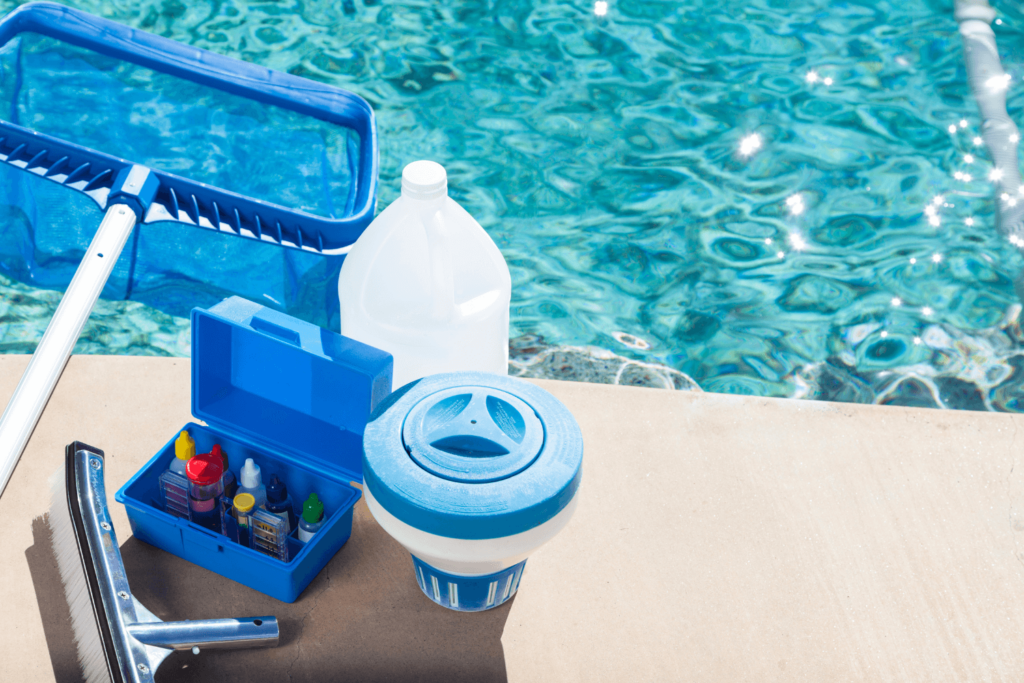
Pool Area Maintenance Tasks You Shouldn’t Skip
Even diligent pool owners miss key maintenance steps. Use this checklist to catch commonly forgotten tasks and keep your pool area safer and more efficient year-round.

There’s nothing quite like the joy of using your safe, private home swimming pool and nothing quite like the disappointment of stepping outside to be greeted with green pool water. Don’t feel bad. It can happen to the best of us. Green water looks bad, often smells bad, and can turn your backyard oasis into a wet headache, but it doesn’t have to. As your swimming pool experts, we’ll walk you through how to treat green pool water, restore your swimming pool’s clarity, and prevent it from forming again so you can get back to using your pool as your source of exercise, relaxation, and fun for the whole family.
When your water turns green, it’s a sure sign something is wrong. There are several reasons your water can turn green, but of the possibilities, one stands above all others:
If the issue hasn’t reached the point where an evident smell points you in the right direction, it can be hard to know the exact cause of the green water in your pool. Some algae can be yellowish, and if a problem is caught early enough, no odor may be present. Luckily, it doesn’t matter much because the answer to each of them lies in the Three C’s of proper pool maintenance.
Addressing these three critical areas of pool maintenance will get rid of green pool water faster and keep it at bay longer.
Treating your pool requires a little TLC, but there isn’t a lot of specialized equipment that you’ll need. Make sure you have your normal pool cleaning equipment on hand, know how to clean your filter medium property through backwashing, and that you have your normal pool chemistry supplies plus a dose of pool shock. Let’s get started.


Now that your water is clear, it’s time to make sure it stays that way. If the process of fixing the issue has you worn out, don’t worry. As with most situations, it’s far easier to prevent a problem than to fix it once it shows up.
Our independent All-Safe Pool installer is your local safer pool expert. They’ll set up a time to talk to you about your pool needs, measure your pool area, and tailor a safety quote that lays out your pool protection options. It’s cost-effective peace of mind for you and your loved ones. Reach out for your no-cost, no-obligation quote from your local All-Safe Pool pro today.

Even diligent pool owners miss key maintenance steps. Use this checklist to catch commonly forgotten tasks and keep your pool area safer and more efficient year-round.

Learn the most common pool winterizing mistakes and how to avoid them for a safer, cleaner backyard during the off-season.

Mesh pool covers offer reliable winter protection by keeping out debris and preventing accidents. Learn why they’re a smart choice for safety and peace of mind.
Enter your zip code to locate an independent installer in your area
Enter your zip code to locate an independent installer in your area

Due to the many variations in monitors, phones, and browsers, color samples and product examples may appear different on different screens. Computers and mobile devices are not all calibrated equally and color reproduction on the Internet is not precise. The same is true for printed items such as brochures and other sales literature.
In addition, the colors of our products photograph differently under different lighting conditions. For example, photos taken in full sunlight will vary from photos taken on a cloudy or overcast day. Similarly, shadows from nearby objects can affect the color and transparency of our products. If a precise color or specific shade is important, please inspect the actual color of your product prior to installation.
Many of our products’ materials are not available through typical stores and vendors and therefore must be custom manufactured specifically for our use. In order to control costs and provide you with the best value possible, our raw materials are produced in large batches and can often take several months to receive. The colors of our materials can, and often do, vary slightly from batch to batch. Although we make every effort to minimize color variations, we cannot be responsible for these differences when they occur. If a precise color or specific shade is important, please inspect the actual color of your product prior to installation.
For example, we use the name “putty” to describe some of our products. Your idea of the color “putty” may be different than someone else’s idea of “putty”. In addition, products may have the same color name but may not be the exact same color. For example, we have different shades of “black”. Please do not order using color names as your only guide. If a precise color or specific shade is important, please inspect the actual color of your product prior to installation.
If it is important that your product be an exact color or shade, it is highly recommended that you inspect the actual product prior to its installation and address any concerns with your local independent installer. Most independent installers do not offer refunds or accept returns due to color variations.